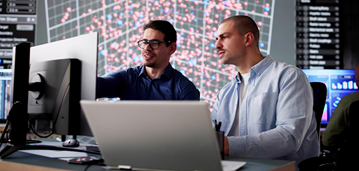Delivering Better Public Service Through the Internet of Things

Read the Delivering Better Public Services Through the Internet of Things white paper.
Technology has had a profound impact on the way we conduct our lives, from our interactions with others to the tasks we perform and the way we entertain ourselves. In the public sector, technology has expanded agencies’ ability to provide services and streamline their operations.
The next evolution in technology has the potential to extend technology’s reach even further, helping the private and public sector alike serve the needs of their customers like never before. The Internet of Things, or IoT, is ushering in a new era of interaction with technology, enabling machines to work together to enhance decision-making and automate processes to improve citizen experiences.
In the corporate space, IoT can help companies reduce costs, increase efficiency and simplify their operations, ultimately resulting in improved customer satisfaction through lower prices and better user experience. The same applies to the public sector.
In the government space, IoT can be an effective tool in delivering public services in a more proactive manner, providing the right people—and systems—with the right information to improve their decision-making and help streamline processes—ultimately saving valuable taxpayer dollars.
IoT is a data-intensive technology, and as such needs a dedicated and mobile network infrastructure that can handle the multiple simultaneous transactions occurring repeatedly and continually. It is imperative agencies have a network that is powerful enough to support an infrastructure designed to power the IoT to enable and deliver better public services.
Check out Our IoT Doing Government Work Infographic
IoT – A Brief Introduction
The concept behind the IoT is not new. Machine-to-machine interaction has been happening for many years. Traditionally, however, the data from these machines was simply collected and stored for data mining later on, not providing much in the way of value beyond a specific data point.
Today, machine-to-machine interaction has moved well beyond its initial purpose, thanks to advances in chip design and manufacturing creating better platforms and better connectivity. Those elements, combined with data analytics, create a powerful solution that combines intelligence with automation. Consider, for example, a vending machine that senses when it’s running low on a particular snack and sends a message to the inventory control system, which adds a supply of the snack to the route driver’s next batch to be restocked.
In another example, a robotic welding arm in an assembly line can sense automatically when its joint sprocket is about to fail and sends an alert to a robotic mechanic, which replaces the sprocket proactively, preventing the whole assembly line from shutting down.
Such examples demonstrate the power of the IoT to be a catalyst in more efficient, effective operations. This is true for both the private sector and the public sector.
IoT in Government
The use of the IoT in the government space knows no bounds. Agencies can harness the IoT’s capabilities to extend their reach well beyond their traditional parameters. From sensors that alert drivers to the location of open spaces to weather devices that automatically alert snow plow drivers and ready snow plows when inclement weather is imminent, the IoT can give agencies a leg-up in providing services that are light years ahead of today’s capabilities.
The government sector thus far is slow to implement the IoT, however. According a 2015 GovLoop survey, only nine percent of respondents said their agency or organization was actively exploring or using the IoT. More than half (61 percent) said their agency or organization was not actively exploring or using it, while 30 percent were unsure.[1]
The same survey asked whether respondents’ organizations would be using the IoT in some way within the next three years. Only 14 percent responded yes, almost equal to those who responded no (10 percent). The remaining 76 percent were unsure.
Yet, the benefits of the IoT in the public sector are real. Research firm Gartner estimates that 1.1 billion connected things will be used by smart cities in 2015, rising to 9.7 billion by 2020.[2] Specifically, the IoT can impact:
- Employee productivity, through improved labor effectiveness for new and existing government services
- Connected militarized defense and combat-mission effectiveness through improved situational awareness and connected command centers, vehicles and supplies
- Cost reduction, through improved labor efficiency, better capital utilization and reduced operational costs
- Citizen experience, through shorter search times, improved environment and better health outcomes
- Increased revenue, through improved ability to match supply with demand and improved monitoring and compliance
These savings, in turn, translate to more efficient use of taxpayer money and a stronger, more efficient government.
Public Sector IoT Examples
Although thus far the public sector has been slow to adopt the IoT, some municipalities have implemented programs using the technology—and are reaping the benefits. A few examples include "smart parking" that helps drivers find parking spots and solar, internet-connected “smart” trash bins that communicate their status to help optimize collection routes.[3] Other instances focus on law enforcement, using video monitoring to protect citizens and sensors to detect gunshots and automatically dispatch police officers.
Indeed, the possibilities of the IoT in the public sector are endless. And all serve to expand agencies’ opportunities to provide the best possible customer experience in the most efficient manner. Here are some examples of what’s being done and what can be done using the IoT:
Transportation: In the transportation space, the IoT is being used beyond the smart parking example noted above to include smart parking meters, which also can alert drivers of open parking spots as well as notify users when their metered time is close to expiring. Drivers then have the option of adding more time through a smartphone app. As a result, local municipalities have a check and balance in place to ensure that funds are collected and citizens appreciate the opportunity and alerts that prevent them from getting ticketed.
In Singapore, an Electronic Road Pricing system sets toll prices according to traffic flows and an Expressway Monitoring and Advisory System alerts motorists to accidents and other road hazards that might disrupt the flow of traffic. In addition, city taxis are equipped with a GPS system that monitors and reports on traffic conditions around the city to keep traffic moving more freely.
Information from all of these systems is fed into Singapore’s Intelligent Transport System Operations Control Centre, which consolidates the data and provides real-time traffic information to the public, so individuals can make timely decisions about the best routes to travel.[4]
Utilities: Municipalities and utility companies can use the IoT to encourage smart utility use among its customers. Homes, for example, can be equipped with smart water meters to monitor usage—data that is then sent back to the utility and analyzed to determine such things as potential water leaks or peak customer use. The utility can use that information to help the homeowner save money by alerting of possible water leaks or making suggestions to reduce water use.
For example, the Municipal Water Department in East Bay, California saved five percent in water consumption by giving 10,000 customers access to a web portal that showed how each stacked up against families of comparable size, as well as by providing ideas for improving water conservation.[5]
Similarly, gas and electric utilities can monitor usage and suggest individualized tips to help its customers save on their monthly bill. And all three can use data collected from all customers to measure overall use and determine areas of heavier use, then “reroute” the water, gas or electricity to meet the demands of high-use areas.
Law Enforcement: Cities across the country are grappling with ways they can keep their police, fire, EMS and other first responder personnel safe while performing their duty to serve the public. The IoT is helping ensure that safety through technologies such as ShotSpotter, which detects when gunshots occur and feeds the location back to police based on data received from multiple sensors. ShotSpotter is being used in major cities in the United States, including New York, Boston, Oakland, San Francisco, Minneapolis and Washington, D.C.[6] Connected devices can help on a more personal level, as well. Wearable technology on officers’ uniforms could monitor their stress levels as well as heart rate and voice volume and alert other officers and higher-ups of potentially volatile situations. Additionally, those same sensors could detect if an officer has experienced a life-threatening event, such as a wound or heart attack.
“Smart guns” can dispatch backup support when officers remove the guns from their holsters and discharge them, reducing the amount of time it takes for assistance in potentially dangerous situations.
The data from both of these devices can be used to help officers review their response to situations and help in future coaching, training and development.
What's more, some cities are stepping up their use of video to monitor security, traffic and other hazardous conditions, placing video surveillance cameras atop traffic lights and connecting them to provide a more holistic view of happenings for police departments. Some cities are combining video use with “smart street lights” that brighten or dim depending on traffic. In 2015, GE released a smart street light that comes with sensors which can be used to track weather or record video for such things as traffic, pedestrian safety or parking violations. The information can be sent to a cloud-based analytics platform that generates content based on the conditions, such as a traffic accident, for example.[7]
Public Services: Beyond using video to monitor for hazardous conditions, the IoT can help municipalities be proactive in providing often-crucial services to their citizens. Tasks that may seem rather mundane can be enhanced by the IoT, reducing waste in time, money and energy by public sector personnel.
For example, garbage receptacles can be equipped with sensors that can detect and alert public works when they are full. This reduces the time wasted by workers manually checking receptacles to see which ones need emptying.
Weather sensors, meanwhile, can be placed at different locations to monitor conditions and automatically alert snow plow drivers to ready their snow plows when appropriate. In Buffalo, New York, snow plows are equipped with GPS sensors so city executives can track which streets have been plowed. The sensors can also automatically alert citizens via email after their street has been plowed. In addition, the sensors allow staff to monitor the location of every plow, and using color-coded mapping, dispatchers can see which streets a snow plow has cleared.[8]
The IoT also can help public works departments stay proactive in maintaining roadways. In France, IoT road sensors are provide real-time data from roads to help divert the flow of traffic away from areas of hazard. And closer to home, the New Carquinez Bridge in California has been equipped with sensors to see how the bridge performs in various conditions including high winds or earthquakes, and to know automatically when the structure is in need of repairs.[9]
Reaching Out to Rural Areas
The IoT can also be a useful tool when it comes to providing services to rural areas that traditionally have been underserved or difficult to reach. For example, video sensors attached to drones can be used to survey earthquake damage in a location that may not be accessible via roads or to search for lost or missing hikers. Emergency 911 calls made from remote areas also can be investigated using video drones, which can drop supplies to help stranded residents in the case of emergency or catastrophe.
Fire departments can use IoT technology to monitor wildfires, especially in fire-prone areas in higher elevations. Sensors attached to trees can detect areas of intense heat to pinpoint fire origins and spread patterns, helping firefighters better determine how to attack and extinguish the fire quickly.
Rural residents, too, can benefit from IoT technology. Using drones, health practitioners can get necessary medication to ill patients too remote to get to a hospital quickly. In addition, health departments can set up telemedicine systems in rural health clinics to treat all kinds of ailments, from diagnosing the flu to treating diabetes.
The Network is the Key
Each example shows the impact of the IoT on delivering the necessary services citizens need. At the heart of these and other initiatives is a network that can support the infrastructure necessary for the IoT.
Big data is a critical component of the IoT, giving municipalities the ability to provide services faster and more efficiently, and discover new areas of service opportunities, such as in rural areas that in the past were difficult to access. As such, the IoT and big data require appropriate levels of bandwidth, to process the myriad data collected and send out actions based on the data.
The IoT requires a network powerful enough to handle the deluge of data from multiple sources and deliver that data to the resources that can process that data effectively. Ideally, a network should include dedicated, broadband and Wi-Fi service to ensure an always-on, always-available connection to collect the data, deliver it to the cloud, analyze the data and turn the information into actions.
What’s more, municipalities should have a network that can work effectively no matter where users are located. Citywide Wi-Fi combined with dedicated bandwidth running over highly available, redundant networks can keep the information flowing as quickly at the IoT demands.
Comcast Business Can Help
Comcast’s Networking Portfolio includes a full line of connectivity solutions to help municipalities and agencies harness the power of the IoT to provide services swiftly and proactively. Its fiber-rich IP network supports a full line of dedicated, broadband and Wi-Fi connectivity services, ensuring an always-on, always-connected environment that works for everyone.
Comcast Business Managed Broadband and Ethernet solutions are built to support the rigorous network requirements of IoT initiatives. Featuring fast, reliable, secure, scalable Ethernet up to 10Gbps, Comcast’s portfolio of offerings offers a range of available speeds to meet individual bandwidth needs at each location.
As a network services provider, Comcast Business handles every aspect of the network, from provisioning to management. That helps municipalities focus on providing services, not on maintaining their network.
Conclusion
The Internet of Things is ushering in a new era of technology, enabling machines to work together to enhance the way users work, play and interact. In the government space, the IoT can be an effective tool in delivering public services in a more proactive manner, providing the right people—and systems—with the right information to improve their decision-making and help streamline operations—ultimately saving valuable taxpayer dollars.
Photo via Joshua Jackson via Visualhunt.com
[1] GovLoop, “What the Internet of Things Means for the Public Sector,” white paper, October 2015 https://www.govloop.com/pdf-viewer/?file=https://www.govloop.com/wp-content/uploads/2015/10/GovLoop-Internet-of-Things-Guide-.pdf
[2] Anurag Gupta, Bettina Tratz-Ryan, Peter Middleton, “Smart Cities Will Include 10 Billion Things by 2020 — Start Now to Plan, Engage and Position Offerings,” analyst paper, Gartner, March 11, 2015 https://www.gartner.com/doc/3004417?ref=clientFriendlyURL
[3] William D. Eggers, Max Meyers, Claire Niech, “How the Internet of Things Could Transform Public Services,” Governing, Sept. 2, 2015, http://www.governing.com/columns/smart-mgmt/col-internet-of-things-iot-government-services.html
[4] Smart Cities are Built on the Internet of Things,” whitepaper, Lopez Research, Feb. 2, 2014, http://www.cisco.com/c/dam/en_us/solutions/trends/iot/docs/smart_cities_are_built_on_iot_lopez_research.pdf
[5] Eggers, Meyers, Niech, “How the Internet of Things Could Transform Public Services”
[6] Tatiana Schlossberg, “New York Police Begin Using ShotSpotter System to Detect Gunshots,” The New York Times, March 16, 2015, http://www.nytimes.com/2015/03/17/nyregion/shotspotter-detection-system-pinpoints-gunshot-locations-and-sends-data-to-the-police.html?_r=0
[7] Ron Miller, “GE Spotlights New Street Lamps,” TechCrunch, April 16, 2015 https://techcrunch.com/2015/04/16/ge-spotlights-new-smart-street-lamps/
[8] Carl Krupitzer, “How Will the IoT Change How Municipalities are Managed?” ThingLogix blog, Aug. 24, 2015 http://www.thinglogix.com/smart-cities/
[9] Ben Dickson, “How IoT and Machine Learning Can Make Our Roads Safer,” TechCrunch, July 13, 2016 https://techcrunch.com/2016/07/13/how-iot-and-machine-learning-can-make-our-roads-safer/
The Internet of Things has many possible applications in the public sector and is already yielding benefits for organizations the world over.
Locked Content
Click on the button below to get access
Unlock NowOr sign in to access all content on Comcast Business Community
Resource Center
Learn how Comcast Business can help
keep you ready for what's next.











